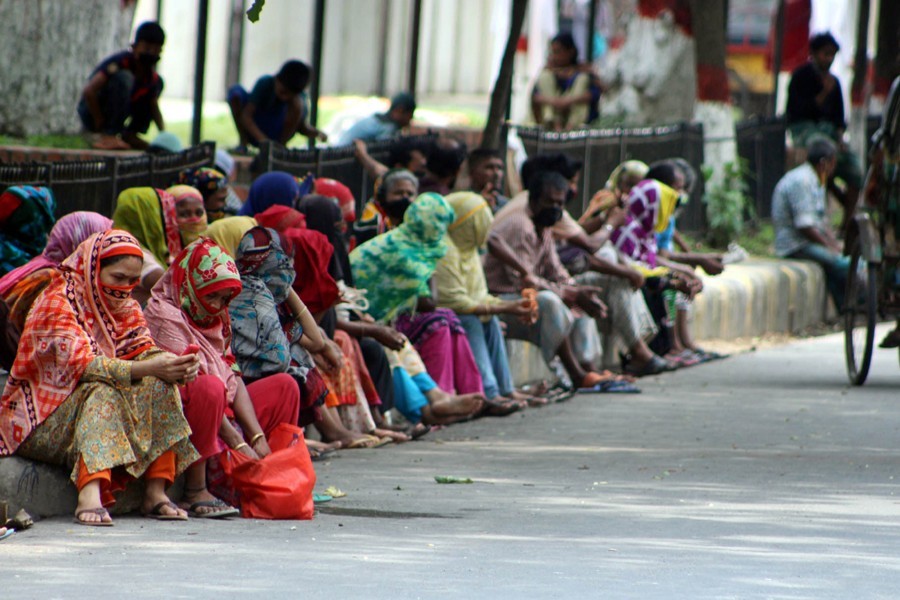The COVID-19 pandemic has pushed 22.9 per cent people of the country below poverty line apart from officially- recognised 20.5 per cent existing poor, according to a rapid survey report.
The report styled "Livelihoods, Coping and Support during COVID-19 Crisis" recommended that over 43 per cent of the country's population, summation of recognised poor and "new poor", require Tk 100 billion fiscal package to survive the pandemic.
The findings of the survey conducted jointly by Power and Participation Research Centre (PPRC) and BRAC Institute of Governance and Development (BIGD) were released on Wednesday.
The survey revealed that due to income shock occasioned by COVID-19, 77.2 per cent vulnerable non-poor, who were not recognised as poor officially before COVID-19, fell below the poverty line in rural area.
In urban area, 87 per cent people fell below poverty line, the survey showed.
The report said in reality, this percentage would be somewhat higher because a portion of the households above medium income also fell into poverty.
"When we compare pre-COVID income of February and reported income of early April, we found vulnerable non-poor 77.2 per cent in rural area and 87 per cent in urban area fell below poverty line," said Dr Hossain Zillur Rahman while launching the report at a webinar on Wednesday.
"We coined a term for this new kind of poor as "new poor" and they really need attention in the time of crisis," he said.
The report said a fiscal package of Tk 47.46 billion per month is required only for the poor and an additional Tk 53.38 billion per month for the "new poor' which makes a combined fiscal package of Tk 100.85 billion per month to support both the poor and 'new poor'.
If the unit support estimated is the average expectation of three groups of poor, extreme poor and vulnerable non-poor, the fiscal requirement is a marginally higher figure of taka, the report said.
It said a large percentage of main income earners in the survey households became economically inactive during the first week of April.
The rate is the highest in urban slums, where 70 per cent of main income earners became inactive, the survey revealed.
More main income earners in poor and extreme poor households were inactive compared to their richer counterparts, the rate, nevertheless, is very high across all income categories 60 per cent and above, according to the findings.
The findings also showed a dramatic and steep decline in the income of all segments of the respondents, indicating a system-wide income shock rather than one limited to a specific group.
The extent of income drop was 75 per cent in urban slums and 62 per cent for rural respondents. There was little regional variation underscoring the generalized nature of the income shock, the report said.
The fall in food expenditure is much smaller than the corresponding drop in income.
For rural households, average food expenditure contracted by 22 per cent while the corresponding drop for the urban slum sample was 28 per cent, the report found.
The survey said reduction in diet diversity appears to be a more pronounced first-order response to the crisis compared to reduction in caloric consumption.
It said 47 per cent of urban respondents and 32 per cent of rural respondents indicated a reduction in food consumption.
The findings said only six per cent urban households moved to their rural homes because of COVID-19.
The report observed that as a vast majority of the urban households have not migrated to the rural areas, it hasn't been possible to cut down on their rental expense, exposing them to greater nutritional vulnerabilities.
The survey sample has a strong poverty bias. In terms of reported February 2020 income, 46 per cent of sample households are extreme poor, 16 per cent moderate poor, 18 per cent vulnerable non-poor and 20 per cent non-poor.
A random sample of 12,000 households from urban slums and rural across eight divisions was selected for a phone survey. The survey was conducted from April 04 to April 12 over phone.
Sample was selected from two previous surveys; census for EMPOWER project of BRAC's Urban Development Programme (UDP) and survey for Strategic Partnership Agreement (SPA) Results Framework-2017, conducted by BRAC's research and evaluation division (BRAC-RED).
A dozen of researcher work on the survey led by PPRC executive chairman Dr Hossain Zillur Rahman and Executive Director, BIGD Dr. Imran Matin.
Speaking at the programme, CPD Chairman Rehman Sobhan expressed his concern saying what would happen to those people in need now as the survey is from early April.
Professor of Development Economics at Ulster University Dr S R Osmani said it seems according to the report half of the country's population require financial assistance.
He advocates a careful financial measure for the people in need in the budget.
Executive Director Asif Saleh said the report findings clearly indicate that the country has long been ignoring vulnerable poor, especially poor in urban areas.


